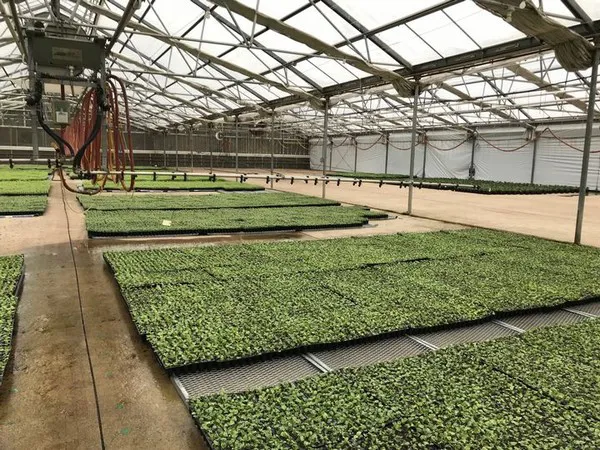Michigan State University Extension has updated their insect and disease management recommendations for the 2020 greenhouse season. There have been some changes from the previous 2019 recommendations. These recommendations are updated yearly to reflect efficacy of pesticides as MSU Extension specialists and their nationwide colleagues perform research trials evaluating the products against common greenhouse insects, mites or diseases. The pesticides are evaluated by a network of researchers involved in the IR-4 Project, a research group that facilitates the labeling of pesticides on specialty crops, including greenhouse crops.

Photo by Heidi Lindberg, MSU Extension
Insect management
MSU Extension entomology specialist for ornamentals, David Smitley has released his “2020 Greenhouse Pest Management with Insecticides” recommendations. These are the recommended products to control thrips, aphids, whiteflies, spider mites, broad and cyclamen mites, fungus gnats, mealybugs and Florida fern caterpillar.
Growers of greenhouse vegetables and greens can use the guide, “Recommended Insecticides for Common Greenhouse Pests on Vegetables, Herbs and Leafy Greens,” when considering an insecticide application. The guide provides the names of the products, active ingredients, vegetable crops on the label and recommended pests they control. For more information on the guide, see the MSU Extension article, "Insecticides for common pests on greenhouse vegetables and transplants."
Changes from 2019
There are two primary changes that differ from the 2019 recommendations. First, there are now management recommendations on leafminers, which include Arena, Mainspring, Conserve and Azaguard. Second, there are three new or re-released insecticides: Altus, Arena and Xxpire. Altus (flupyradifurone) is labeled for use against aphids, leafminers, mealybugs and whiteflies as a foliar spray or systemic soil drench. Arena (clothianidin) is a neonicotinoid with good activity as a systemic soil drench or as a foliar spray against aphids, whiteflies, leafminers and mealybugs. Xxpire should be used as a foliar spray against thrips, whiteflies and aphids.
Xxpire was first released in 2014, however, the registration was voluntarily pulled until it was just recently re-registered in Michigan in 2020. Altus and Xxpire are new or relatively new types of insecticides. They may be helpful in managing insects that have become resistant to heavily-used products that have been on the market for longer periods of time.
Disease management
MSU Extension plant pathologist Mary Hausbeck has released her new "2020 Greenhouse Disease Management" recommendations. The products are classified on a range from “A+” or “B/B-” team products. The “A” team products provide the best control for the diseases, and “B” team products are those that provide limited control and are good to include in a spray rotation.
Hausbeck has also provided an updated “2020 Greenhouse Impatiens Downy Mildew Program” for both susceptible and impatiens downy mildew-resistant cultivars.
Hausbeck and her colleagues have also developed a guide for disease management specifically for vegetable and herb crops. The guide provides the following information about each registered product for vegetable transplants and herbs: 1) active ingredient, 2) trade name of the product, 3) FRAC code (a guide for alternating products to delay/reduce pathogen resistance) and 4) re-entry interval. The disease recommendations are grouped by crop groups: 1) brassica, 2) cucurbit, 3) leafy, 4) fruiting and 5) herbs. Within each crop grouping, the table includes the target pathogen including: bacterial blight, downy mildew, leaf spot, powdery mildew, Phytophthora, Rhizoctonia and Sclerotinia.
Changes from 2019
The biggest changes to the "2020 Greenhouse Disease Management" recommendations are those to the impatiens downy mildew prevention program. The newly-released impatiens cultivars, Imara XDR and Beacon, are not susceptible to impatiens downy mildew. These cultivars were included in many nationwide trials during 2019 and provide an excellent choice especially for use in landscape sites that may be infested with the impatiens downy mildew.
As an "insurance policy," Hausbeck suggests a single drench application of Subdue MAXX (1 fluid ounce per 100 gallons) plus Segovis (3.2 fluid ounces per 100 gallons) prior to shipping impatiens downy mildew-resistant cultivars. The fungicide program for the impatiens downy mildew-susceptible impatiens cultivars includes three separate applications of Subdue MAXX and Segovis during production. For more information, see the MSU Extension article, “Welcome impatiens back into your landscape.”
For Botrytis, there are a few additions to the “A” Team, including:
- Astun (isofetamid)[7]
- Broadform (fluopyram + trifloxystrobin)[7/11]
- Orkestra (fluxapyroxad + pyraclostrobin)[7/11]
- Palladium (cyprodinil + fludioxonil)[9/12]
- Mural (azoxystrobin + benzovindiflupyr)[11/7]
- Medallion/Emblem (fludioxonil – do not apply to geraniums)
For powdery mildew management, MSU research studies have shown differences in control among “A+ Team,” “A/A- Team,” and “B Team” products. The Banol (propamocarb) fungicide is a new addition (FRAC code: 28) to the “A” Team for Pythium control.
If you have questions about these insect and disease management recommendations, contact the author or your local MSU Extension greenhouse educator. You can also find more information on crop safety and efficacy of products on the Environmental Horticulture Research Summaries page of the IR-4 Project website.
Source: Michigan State University (Heidi Lindberg, Mary Hausbeck and David Smitley)
